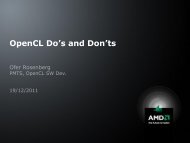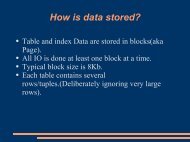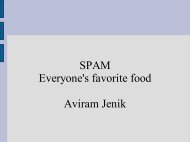Modern Web Applications with Flask and Backbone.js
Modern Web Applications with Flask and Backbone.js
Modern Web Applications with Flask and Backbone.js
You also want an ePaper? Increase the reach of your titles
YUMPU automatically turns print PDFs into web optimized ePapers that Google loves.
<strong>Modern</strong> <strong>Web</strong><strong>Applications</strong> <strong>with</strong> <strong>Flask</strong><strong>and</strong> <strong>Backbone</strong>.<strong>js</strong>/Yaniv (Aknin|Ben-Zaken)/February 2013
<strong>Web</strong> application? <strong>Modern</strong>?CGIReal Time <strong>Web</strong>C10K+; websockets; CometStatic files20001990 2010tHTML 1.01 st MVC FrameworksASP; ColdFusion; PHP1 st Browser WarMSIE 6.0 ; Netscape 4.0RESTish APIs2 nd MVC FrameworksDjango; Rails2 nd Browser WarMSIE; Firefox; <strong>Web</strong>kit; V8Proprietary PluginsHTML5/CSS3Adobe FlashSPA / Frontend MVCHTML4/CSS1/AJAX
MVC● MVC is a design pattern● Introduced in SmallTalk in the 70'● Parts● Model - the data● View - the presentation of the data● Controller - user interaction● Move javascript implementations are some variation onthe pattern <strong>and</strong> not pure MVC
MVCWhy do we need a client side MVCish solution?A simple list <strong>and</strong> a counter exampleNo client side data manipulationGetting the listServer6Client6HTML
MVCWhy do we need a client side MVCish solution?A simple list <strong>and</strong> a counter exampleNo client side data manipulationSending a delete actionServerClient6
MVCWhy do we need a client side MVCish solution?A simple list <strong>and</strong> a counter exampleNo client side data manipulationGetting an updated page - List <strong>and</strong>counter are syncedServer5Client5HTML
MVCWhy do we need a client side MVCish solution?A simple list <strong>and</strong> a counter exampleClient side data manipulation by dom mutationGetting the listServer6Client6HTML
MVCWhy do we need a client side MVCish solution?A simple list <strong>and</strong> a counter exampleClient side data manipulation by dom mutationSending a delete request <strong>and</strong> gettingconfirmationServerClient6DeleteConfirmationAJAX
MVCWhy do we need a client side MVCish solution?A simple list <strong>and</strong> a counter exampleClient side data manipulation by dom mutationClient side removes the item <strong>and</strong>update the counter to matchServerClient5Update thecounterThe down-side of the data being mixed <strong>with</strong> therepresentation is that each data manipulation codemust be aware of all the existing ways it is shown,<strong>and</strong> update them.
MVCWhy do we need a client side MVCish solution?A simple list <strong>and</strong> a counter exampleClient side data manipulation by dom mutationUpdating every other representationof this dataServerClient5Update thecounter, ANDTHE OTHERLISTSuppose we want to have a thumbnail list widget inthe corner, we'll have to update the delete code toupdate that as well.
MVCWhy do we need a client side MVCish solution?A simple list <strong>and</strong> a counter exampleClient side data manipulation by dom mutationUpdating every other representationof this dataServerClient5Update thecounter, ANDTHE OTHERLISTSuppose we want to have a thumbnail list widget inthe corner, we'll have to update the delete code toupdate that as well.
MVCWhy do we need a client side MVCish solution?A simple list <strong>and</strong> a counter exampleClient side data manipulation using a model <strong>and</strong> mutiple viewsThe server sent only data, not html.The html is built by the views.ServerModelViewsJSONDATA5AJAXAfter a delete, the model is changed.The views Observe the model <strong>and</strong> updatethemselves after a change. The model isn't aware ofthe different views <strong>and</strong> their implementation.Code is easier to maintain.
<strong>Web</strong> Application: conceptsBackendFrontendPersistence Logic(Resource State)Pages <strong>and</strong> AssetsMisc. Legacy resourcesUILayoutValidationNon persistent logic(Session state)Easy to get started -challenges aretypically <strong>with</strong>deployment, scale,monitor, secure, etc
<strong>Web</strong> Application: rolesBackendFrontendAPIAuthAssetsDeploymentBatch jobs(no views!)RESTishAPITemplatingBrowser AbstractionMVC FrameworkScripting/stylesheetsyntactic sugarPixel Perfection
RESTish●●●●●REST: Architectural style pioneered by Roy FieldingOften misunderstood <strong>and</strong> misimplementedStrict adherence to constraints defines RESTfulnessRESTish is what we call "REST inspired" servicesCommon principles○ client-server over HTTP○ resource oriented & uniform interface○ stateless (or stateleast)○ layered <strong>and</strong> cachable○ not really RESTful...
Crash course: FLSK 101#!/usr/bin/env pythonfrom flask import <strong>Flask</strong>app = <strong>Flask</strong>(__name__)@app.route('/')def hello_world():return 'Hello World!'if __name__ == '__main__':app.run(debug=True)
Things to keep in mind●●●●●<strong>Flask</strong> is surprisingly thinRead the source, LukeGet familiar <strong>with</strong> WerkzeugBrilliant context locals are brilliant<strong>Flask</strong> in under ten lines:class <strong>Flask</strong>(_PackageBoundObject):...def wsgi_app(self, environ, start_response):<strong>with</strong> self.request_context(environ):try:response = self.full_dispatch_request()except Exception, e:rv = self.h<strong>and</strong>le_exception(e)response = self.make_response(rv)return response(environ, start_response)
Crash course: FLSK 102#!/usr/bin/env pythonimport osfrom httplib import ACCEPTED, FORBIDDENfrom flask import <strong>Flask</strong>, requestapp = <strong>Flask</strong>(__name__)@app.route('/', methods=['DELETE'])def reboot():if request.values.get('password') == 'secret':os.system('sudo shutdown now')return 'ok', ACCEPTEDreturn 'no', FORBIDDENif __name__ == '__main__':app.run()
Crash course: FLSK 103@app.route('/')def show_entries():cur = g.db.execute(SELECT_SQL)ent = [dict(ttl=r[0], txt=r[1]) for r in cur.fetchall()]return render_template('show_entries.html', ent=ent)@app.route('/add', methods=['POST'])def add_entry():if not session.get('logged_in'):abort(UNAUTHORIZED)g.db.execute(INSERT_SQL, [request.form['title'],request.form['text']])g.db.commit()flash('New entry was successfully posted')return redirect(url_for('show_entries'))
Crash course: FLSK 103✘@app.route('/')def show_entries():cur = g.db.execute(SELECT_SQL)ent = [dict(ttl=r[0], txt=r[1]) for r in cur.fetchall()]return render_template('show_entries.html', ent=ent)@app.route('/add', methods=['POST'])def add_entry():if not session.get('logged_in'):abort(UNAUTHORIZED)g.db.execute(INSERT_SQL, [request.form['title'],request.form['text']])g.db.commit()flash('New entry was successfully posted')return redirect(url_for('show_entries'))This is server side MVC!(read: not our cup of tea)
Crash course: FLSK 103@app.route('/user/')def user_page(id):User.query.get_or_404(id)return render_template('user.html',user_id = id,){% extends "webapp.html" %}{% block head %}{{ super() }}window.xx.context.user_id = {{ user_id|to<strong>js</strong>on|safe }};$(function() { UserPage({el: $('.user_page')}); });{% endblock %}{% block body %}{{ super() }}{% endblock %}
Crash course: FLSK 103@app.route('/user/')def user_page(id):User.query.get_or_404(id)return render_template('user.html',user_id = id,){% extends "webapp.html" %}{% block head %}{{ super() }}window.xx.context.user_id = {{ user_id|to<strong>js</strong>on|safe }};$(function() { UserPage({el: $('.user_page')}); });{% endblock %}{% block body %}{{ super() }}{% endblock %}Complete View & Template of user page(you're not seeing much here - that's the point!)
Crash course: FLSK 103@app.route('/user/')def user_page(id):User.query.get_or_404(id)return render_template('user.html',user_id = id,){% extends "webapp.html" %}{% block head %}{{ super() }}window.xx.context.user_id = {{ user_id|to<strong>js</strong>on|safe }};$(function() { UserPage({el: $('.user_page')}); });{% endblock %}{% block body %}{{ super() }}{% endblock %}Complete View & Template of user page(you're not seeing much here - that's the point!)
flask-assets crash course●●●<strong>Flask</strong> extension wrapping the webassets packageDeclaratively define your pages' assetsAssets are filtered during deployment / on the fly (development)from flask.ext.assets import Environment, Bundlefrom .app import appassets = Environment(app)coffee = Bundle('<strong>js</strong>/lib/lib.coffee', '<strong>js</strong>/lib/auth.coffee',filters="coffeescript", debug=False,output="gen/base.coffee.<strong>js</strong>")<strong>js</strong> = Bundle('<strong>js</strong>/vendor/underscore.<strong>js</strong>','<strong>js</strong>/vendor/backbone.<strong>js</strong>', coffeeoutput="gen/base.<strong>js</strong>", filters="yui_<strong>js</strong>")assets.register('base.<strong>js</strong>', <strong>js</strong>)
flask-assets crash course●●●<strong>Flask</strong> extension wrapping the webassets packageDeclaratively define your pages' assetsAssets are filtered during deployment / on the fly (development)from flask.ext.assets import Environmentfrom utils.flaskutils import register_assetsfrom .app import appspec = {"base.<strong>js</strong>": ('<strong>js</strong>/lib/lib.coffee','<strong>js</strong>/lib/auth.coffee','<strong>js</strong>/vendor/underscore.<strong>js</strong>','<strong>js</strong>/vendor/backbone.<strong>js</strong>')}register_assets(assets, spec)
flask-restful crash course●"<strong>Flask</strong>-RESTful provides the building blocks for creating a great REST API"○ Read: "...for easily creating a decent RESTish API"○ Intensely down-to-business, not coupled to anything (db, etc)○ Highly recommended, still under developmentfrom myproject import appfrom flask.ext import restfulapi = restful.Api(app)class HelloWorld(restful.Resource):def get(self):return {'hello': 'world'}api.add_resource(HelloWorld, '/')
flask-sqlalchemy crash course●●●<strong>Flask</strong> extension wrapping the incredible SQLAlchemy packageEvery ORM I saw trades power for simplicity - SA trades very little poweryet stays decently simpleGreat layered approach from high level ORM to declarative API for SQLfrom flask.ext.sqlalchemy import SQLAlchemyfrom .app import appdb = SQLAlchemy(app)class User(db.Model):id = db.Column(db.Integer, primary_key=True)username = db.Column(db.String(80), unique=True)def __init__(self, username):self.username = usernamedef __repr__(self):return '' % self.username
Two great tastes that tastegreat together!class Marshallable(Resource):method_decorators = (marshal_<strong>with</strong>(self.fields),)class Entity(Marshallable):def build_query(self):return self.model.querydef get(self, id):return self.build_query().get_or_404(id)class UserMixin(object):fields = {"username": String}model = models.Userclass User(UserMixin, Entity):passapi.add_resource(User, '/api/users/',endpoint='api_user')
Suggested project layout$ find * -maxdepth 2 | vi -manage.pyrequirements.txtruncomm<strong>and</strong>s.shbackend/api/app.pyassets.pyauth.pymodels.pystatic@templates/views.pyconfig/settings.pyfrontend/index/core.coffeecore.scsshello_world.<strong>js</strong>tutils//
Suggested project layout$ find * -maxdepth 2 | vi -manage.pyrequirements.txtruncomm<strong>and</strong>s.shbackend/api/app.pyassets.pyauth.pymodels.pystatic@templates/views.pyconfig/settings.pyfrontend/index/core.coffeecore.scsshello_world.<strong>js</strong>tutils//
Bonus slide: authentication●●●Make sessions a resourcePUT for login, DELETE for logout, GET for whoamiEasy to implement <strong>with</strong> flask-login <strong>and</strong> flask-restfulclass Session(Resource):fields = dict(basic_user_fields)def marshal(self, user):return marshal(user, self.fields)def get(self):if current_user:return self.marshal(current_user), OKreturn None, NO_CONTENTdef delete(self):if not current_user:return None, NO_CONTENTlogout_user()return None, RESET_CONTENT@parse_<strong>with</strong>(Argument('kind', required=True, choices=backends))def put(self, params):try:user, created = backends[params.kind]()return self.marshal(user), CREATED if created else OKexcept InvalidAuth, error:return {"message": error.msg}, error.status
<strong>Backbone</strong>●●●Provides small amount of useful building blocks <strong>and</strong> therest is up to youHas a strong following <strong>and</strong> a lot of extensions areavailableMain parts:○ Model○ View○ Collection○ Router○ Events - All of the parts can be used <strong>with</strong> a pub/sub pattern usingbackbone events methods○(*Templates) - <strong>Backbone</strong> doesn't come <strong>with</strong> templating, you can useany <strong>js</strong> templating solution. We will use underscore's templates.
<strong>Backbone</strong>The files which make up our example's frontend app:AppView.coffeeRouter.coffeeTodoCollection.coffeeTodoModel.coffeeTodoView.coffeeapp.coffeecssimg<strong>js</strong>t
<strong>Backbone</strong> - Model●●●Used for dataYou get listen to change eventsCan be have a url <strong>and</strong> be synced <strong>with</strong> the backendwindow.jj.TodoModel = class TodoModel extends <strong>Backbone</strong>.Modeldefaults:title: ''completed: falsetoggle: ->@save { completed: !@get('completed') }
<strong>Backbone</strong> - Collection●●●A collection is a list of modelsUseful events for a model add, remove, change, etcAlso can be fetched or sent as whole to the serverwindow.jj.TodoCollection = class TodoCollection extends <strong>Backbone</strong>.Collectionmodel: jj.TodoModelurl : "/api/todos/"completed: ->return @filter((todo) ->return todo.get('completed'))remaining: ->return @<strong>with</strong>out.apply @, @completed()nextOrder: ->if not @lengthreturn 1return @last().get('order') + 1comparator: (todo) ->return todo.get('order')
<strong>Backbone</strong> - View - single item●●●H<strong>and</strong>les a dom element or sub-viewsOpen for interpretation, <strong>and</strong> has many ways to useUsually will listen to a Model's changes <strong>and</strong> re-renderitself when neededwindow.jj.TodoView = class TodoView extends <strong>Backbone</strong>.ViewtagName: 'li'template: _.template jj.<strong>js</strong>t["todo/<strong>js</strong>t/item.<strong>js</strong>t"]events:'click .toggle': 'toggleCompleted''dblclick label': 'edit''click .destroy': 'clear''keypress .edit': 'updateOnEnter''blur .edit':'close'initialize: ->@listenTo @model, 'change', @render@listenTo @model, 'destroy', @remove@listenTo @model, 'visible', @toggleVisibleUser interactionListens to modelchangesrender: ->@$el.html @template(@model.toJSON())@$el.toggleClass 'completed', @model.get('completed')@toggleVisible()@$input = @$('.edit')return @Render theelement
<strong>Backbone</strong> - View - single itemtoggleVisible: ->@.$el.toggleClass 'hidden', @isHidden()isHidden: ->isCompleted = @model.get('completed')return (!isCompleted <strong>and</strong> (jj.app?.TodoFilter is 'completed')) or (isCompleted<strong>and</strong> (jj.app?.TodoFilter is 'active'))toggleCompleted: ->@model.toggle()edit: ->@$el.addClass 'editing'@$input.focus()close: ->value = @$input.val().trim()if value@model.save { title: value }else@clear()@$el.removeClass 'editing'updateOnEnter: (e) ->if e.which is jj.ENTER_KEY@close()clear: ->@model.destroy()Update themodelRemove themodel
<strong>Backbone</strong> - View - items list●●We can see the view manages item viewsAlso listens to the router for url/hash changes <strong>and</strong>updates statewindow.jj.AppView = class AppView extends <strong>Backbone</strong>.Viewtemplate: _.template jj.<strong>js</strong>t["todo/<strong>js</strong>t/app.<strong>js</strong>t"]statsTemplate: _.template jj.<strong>js</strong>t["todo/<strong>js</strong>t/stats.<strong>js</strong>t"]events:'keypress #new-todo': 'createOnEnter''click #clear-completed': 'clearCompleted''click #toggle-all': 'toggleAllComplete'initialize: ->@buildElement()@allCheckbox = @$('#toggle-all')[0]@$input = @$('#new-todo')@$footer = @$('#footer')@$main = @$('#main')User interactionevents@listenTo @collection, 'add', @addOne@listenTo @collection, 'reset', @addAll@listenTo @collection, 'change:completed', @filterOne@listenTo @collection, 'all', @render@initRouter()@collection.fetch()initRouter : ->@router = new jj.Router()@listenTo @router, 'route:filterSet', @updateFilterListens to collectionchangesListens to therouter
<strong>Backbone</strong> - View - items listbuildElement: ->@.$el.html @template()render: ->completed = @collection.completed().lengthremaining = @collection.remaining().lengthif @collection.length@$main.show()@$footer.show()@$footer.html @statsTemplate({completed: completedremaining: remaining})@$('#filters li a').removeClass('selected').filter('[href="#/' + ( jj.app?.TodoFilter or '' )+ '"]').addClass('selected')else@$main.hide()@$footer.hide()@allCheckbox.checked = !remainingupdateFilter : (param) ->jj.app.TodoFilter = param.trim() or ''@filterAll()Building the mainelementManaging visibilityaccording to filtersaddOne: (todo) ->view = new jj.TodoView({ model: todo })$('#todo-list').append view.render().eladdAll: ->@$('#todo-list').html('')@collection.each(@addOne, @)...Managing the listitems rendering
<strong>Backbone</strong> - Launching it all●●We initialize our main view <strong>and</strong> pass to it the dom element it is responsiblefor <strong>and</strong> the collectionIn general it is easier to maintain views that don't expect dom elements tobe already present or models that are on a expected global (principle ofleast privilege)Existing DOM:Double-click to edit a todoBased on the work of Addy OsmaniPart of TodoMVCModified by Yaniv Ben-Zaken (@cizei)app.coffee code:$ ->jj.app = new jj.AppViewel : $('#todoapp')collection : new jj.TodoCollectionThis all the HTML <strong>and</strong>JS you have in orderto launch the app. Allthe rest is in templateswhich get renderedafter by code this 4 <strong>js</strong>lines launch.<strong>Backbone</strong>.history.start()
<strong>Backbone</strong> - Template●●<strong>Backbone</strong> come <strong>with</strong> it's own templating systemThere are many libraries for <strong>js</strong>-templates you can plug in <strong>and</strong> use, in mostof them basically you convert a string to function which will accept a keyvalue pairings as context <strong>and</strong> give you back an html stringItem template example (using underscore.<strong>js</strong> templates):
<strong>Web</strong> Application: packagesBackendFrontendflask-restfulflask-sqlalchemyflask-loginflask-assetsflask-scriptrq(postgres, redis,gunicorn, gevent)RESTishAPI<strong>Backbone</strong>.<strong>js</strong>jQueryunderscore.<strong>js</strong>CoffeeScriptSCSS
Additional resources●!flask-todo: "modern webapp" based on real codehttps://github.com/fusic-com/flask-todo●●●●●In <strong>Flask</strong> we Trust (great <strong>Flask</strong> primer)http://ua.pycon.org/static/talks/davydenko.pdfThoughts on RESTful API Design (don't do REST <strong>with</strong>out this!)https://restful-api-design.readthedocs.org/en/latest/Fielding on poor REST implementations (read the links, too)http://roy.gbiv.com/untangled/2008/rest-apis-must-be-hypertext-drivenhttp://roy.gbiv.com/untangled/2008/specializationAddy Osmani's TodoMVChttp://addyosmani.github.com/todomvc/Coverage of MVC history <strong>and</strong> client side solutions http://addyosmani.com/blog/digesting-javascript-mvc-pattern-abuse-or-evolution/
Thank you!yaniv@aknin.name (@aknin)me@yaniv.bz (@cizei)(pssst: All that stuff sounds cool?is hiring! Talk to us!)
















